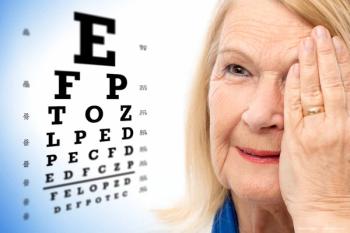
What non-retina specialists need to know about dry AMD
A large-scale, collaborative, systems biology approach is needed to expedite the discovery of treatments for dry AMD-a leading cause of blindness among people 65 and older for which is there is no treatment-according to a report by a working group of scientists appointed by the National Advisory Eye Council (NAEC).
Age-related macular degeneration (AMD) is the leading cause of blindness worldwide among the elderly, and its prevalence is expected to increase as the population ages.1
There are two forms of this sight-stealing disease: dry AMD and wet AMD. Although wet AMD is chronic and incurable, the disease is manageable with anti-VEGF injections. Vision can be maintained, or even improve, with consistent, regular, anti-VEGF treatment.
Both forms of AMD involve a complex interplay of pathogenic factors, including genetics and lifestyle risk factors such as smoking. Research thus far has failed to decipher how these various factors interact in dry AMD and success in doing so would require a large-scale, collaborative and multidisciplinary approach.
To address this issue, a large-scale, collaborative, systems biology approach is needed to expedite the discovery of treatments for dry AMD-a leading cause of blindness among people 65 and older for which is there is no treatment-according to a report by a working group of scientists appointed by the National Advisory Eye Council (NAEC).2
The NAEC is a 12-member panel that guides the National Eye Institute (NEI), part of the National Institutes of Health. The NAEC charged the working group to assess the state of research on dry AMD and to propose directions for future research.
“The working group thoroughly assessed what is known about dry AMD pathobiology, and the recommendations will be informative for considering future NEI research priorities to align with promising pathways for discovering therapeutic targets,” said NEI Director, Paul A. Sieving, MD, PhD.
Further understanding risk factors
There are multiple genetic and environmental factors at play in the development of AMD. More than 40 genetic variants have been associated with AMD, including APOE, CHF, and HTRA/ARMS2. The discovery of these gene variants have helped identify potential therapeutic targets, and gene therapy clinical trials are currently underway for the treatment of the wet subtype.3,4
“We propose that researchers utilize a systems biology approach, integrating the big data available from clinical registries and various fields of biology known as ‘omics’ to develop better models and ultimately treatments for patients with this blinding disease,” said report co-authorJoan W. Miller, MD, chairman, Harvard Medical School Department of Ophthalmology, Boston.
“This approach would integrate basic, genomic, pre-clinical, medical, pharmacological, and clinical data into mathematical models of pathological processes at different stages of dry AMD in order to ask how relevant individual components act together within the living system,” Dr. Miller said.
Development of new imaging technologies
Standard-of-care imaging for AMD diagnosis, classification of disease severity, and the evaluation of treatment efficacy currently include color fundus photographs, optical coherence tomography (OCT), and OCT-angiography.
Handa et al. suggest that new imaging technologies could help identify preclinical risk factors or currently unknown AMD subtypes that may impact disease progression and treatment efficacy by allowing physicians to see cellular and subcellular structures at different disease stages.
For example, “when used with a scanning laser ophthalmoscope and OCT, adaptive optics systems can visualize individual cones, changes in rods, RPE [subretinal pigmented epithelial], and SDD [subretinal drusenoid deposits] in dry AMD,” the researchers write.
Other novel imaging modalities suggested include polarization-sensitive OCT, fluorescence lifetime, and hyperspectral fluorescence. They note, however, that more data and larger clinical trials are needed to confirm the utility of these new imaging technologies, as existing trials have been in small study populations with variable follow-up.
“To advance our understanding, we must identify imaging biomarkers of early changes that reflect AMD pathobiology, predict disease progression and/or treatment response, and correlate with molecular markers that are relevant in both animal models and humans,” they conclude.
Precision medicine through clinical trials
Much like in patients with cancer, Handa et al. believe dry AMD can and should be treated through personalized, precision medicine. To do so, they advocate for individually tailoring computer models to assess a person’s potential risk for developing dry AMD, progression rate, and potential response to treatment.
For this to be effective, however, the group acknowledged that drugs must first be developed for the dry AMD population through robust clinical trials. They further recommend partnering with pharmaceutical companies to developing these trials, with patients followed closely long term.
Finally, patients with dry AMD should be encouraged to donate their eyes to science after they die to further research efforts.
With these efforts and approaches, Handa et al. hope to expedite the research and development of dry AMD treatments.
Disclosures:
1. Wong WL, Su X, Li X, et al. Global prevalence of age-related macular degeneration and disease burden projection for 2020 and 2040: a systematic review and meta-analysis. The Lancet Global Health;2:e106-e116.
2. Handa JT, Bowes Rickman C, Dick AD, et al. A systems biology approach towards understanding and treating non-neovascular age-related macular degeneration. Nature communications 2019;10:3347.
3. REGENXBIO. REGENXBIO Announces Additional Positive Interim Phase I/IIa Trial Update for RGX-314 for the Treatment of Wet AMD at the American Academy of Ophthalmology 2019 Annual Meeting, 2019.
4. Grishanin R, Vuillemenot B, Sharma P, et al. Preclinical Evaluation of ADVM-022, a Novel Gene Therapy Approach to Treating Wet Age-Related Macular Degeneration. Molecular therapy : the journal of the American Society of Gene Therapy 2019;27:118-129.
Newsletter
Keep your retina practice on the forefront—subscribe for expert analysis and emerging trends in retinal disease management.












































